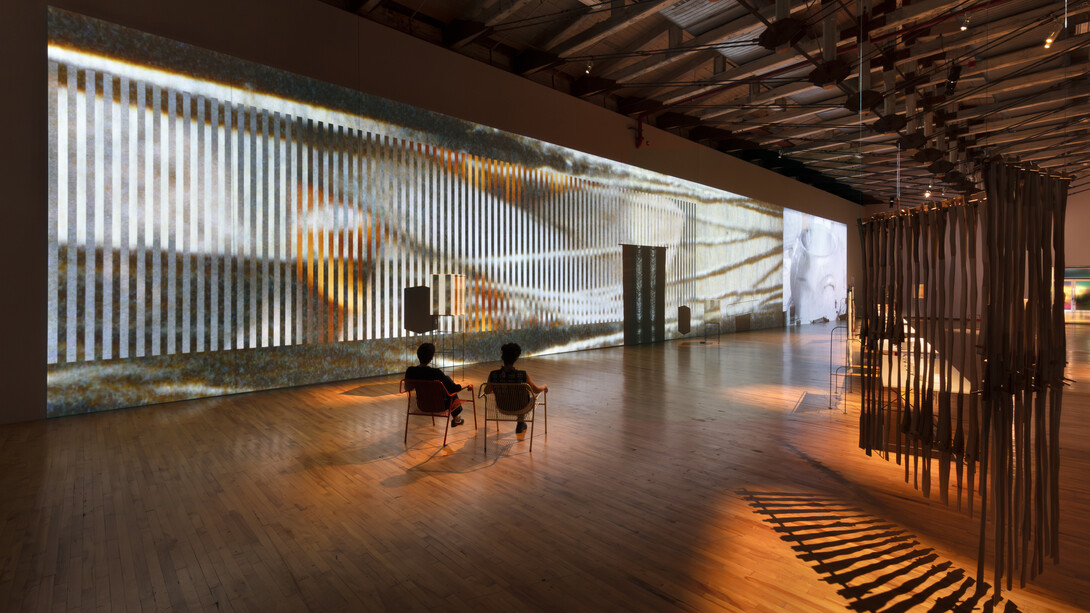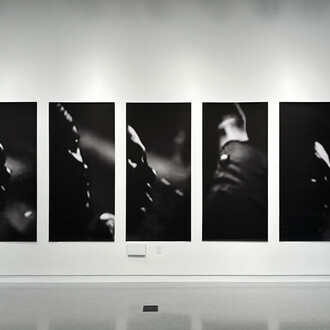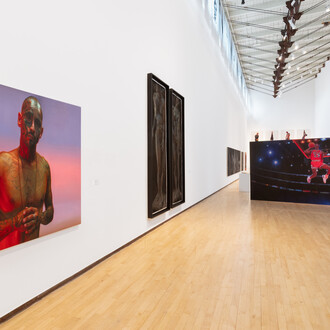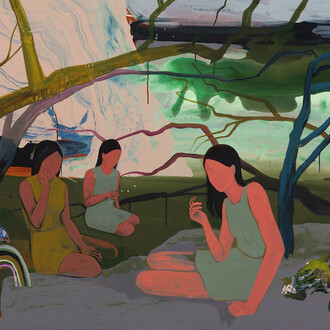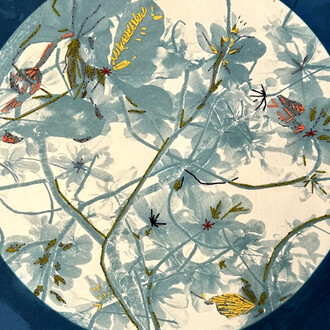MASS MoCA is pleased to present Jimena Sarno: Rhapsody, the artist’s first major solo museum exhibition, which engages craft traditions to imagine a future built on values of collectivity, reconfiguration, and repair. For Rhapsody, Sarno collaborated with artists, teachers, and makers, most of whom are from the Global South, combining filmmaking, sound, and sculpture with contemporary and traditional craft practices to illuminate how sharing time, space, and resources can deepen solidarity within a global context of extreme violence, fragmentation, and destruction.
“Over the past five years, Jimena and I have thought together about the ways that reconfiguration, repair, and solidarity can be used to navigate and translate across borders. We hope that visitors and the community will be inspired by the makers and networks represented in Rhapsody to remember their interconnectedness as they build the future together,” says Alexandra Foradas, former MASS MoCA curator and presently the Haskell Curator of Modern and Contemporary Art at the Princeton University Art Museum.
“It is wonderful to welcome Jimena Sarno back to MASS MoCA and to be able to share more of her practice with our visitors, having first presented her work in the group exhibition Kissing through a curtain in 2020-2022. We are also thrilled to welcome back as guest curator Alexandra Foradas,” states Susan Cross, Interim Director of Visual Arts, MASS MoCA.
Informed by travel to Perú and Argentina (where she was born) within the context of Andean cosmology and tradition, the central installation in the exhibition features a group of objects made using a variety of techniques including weaving, felting, woodworking, and ceramics that rely on bodies of knowledge passed from maker to maker. These objects are tools — at once utilitarian and utopian — designed for a hoped-for, not-so-distant future built on solidarity and mutual care. This assemblage of domestically-scaled, speculative tools made by more than a dozen artists underscores the significance of interdependence and collectivity. Displayed on portable tables, these objects cast shadows across a 100-foot-long film projection interlacing footage of Sarno learning to weave with the same landscapes that were the backdrop to her process.
“The loom functions as a narrative space, and weaving as a metaphor for the interconnectedness of all beings. For Rhapsody, I have transposed this generative space into a monumental projection, in which film montage echoes the weaving process.” Sarno’s film is accompanied by changing soundscapes composed by collaborators including Bergsonist, Dirar Kalash, Mhamad Safa, and Val Jeanty,” notes Sarno.
Additionally, Sarno’s exhibition brings together three other works: two installations incorporating film, sound, and sculpture titled A life in the forest and Las tres gracias, and text/ile (textile and text) library.
A life in the forest, commissioned for Sarno’s exhibition at MASS MoCA, centers on the conservation of a small mother-and-child pair of deer, sculpted in wood by the artist’s late uncle in the 1950’s. Sarno has collaborated with conservators to repair the original wooden sculptures, using 3-D scanning, wood carving, and gilding to replace the missing ears and legs. It includes a sonic composition sampled from the instrumental soundtrack for a musical based on Bambi (1942) by Walt Disney Productions, and a film shot in Super 8 documenting the repair process for the wooden deer in Argentina’s Bosque de Los Arrayanes (known in english as the Myrtle Forest) which also inspired Disney. The sculpture’s deer motif can be traced back to Bambi: a life in the forest, a 1923 novel allegorizing the ills of fascism by Felix Salten. The installation also features a host of additional objects repaired by community members over the course of a series of repair workshops.
The work entitled Las tres gracias interrogates Western civilization’s myth of democracy through creation myths and Third World poetry. Receiving its name from a missing neoclassical sculpture by Italian sculptor Antonio Canova, Las tres gracias — which once stood in the botanical gardens of Buenos Aires and the artist’s subsequent search for it — depicts the three daughters of the Greek god Zeus, believed to bestow beauty, mirth and grace upon humanity. The installation adopts the structure of Greek tragedy, with felted speakers cast as actors playing the Graces, and a crowd of eight suspended speakers standing in for the chorus. The Graces sing operatic stories that weave South American creation myths, colonial plunder, extractivism, and the collective responsibility of living in just relation with all beings. The installation also features a two-channel video, created by Sarno in Super 8 film, capturing scenes from various botanical gardens — a libretto in which Sarno interweaves fragments of texts written by South American revolutionaries and journalists, all of whom were poets; vocal music by American composer and vocal artist Molly Pease; and percussion improvisations composed and performed by Italian percussionist Valentina Magaletti.
The text/ile library contains a collection of writings and textiles that provide context for and have influenced Sarno’s practice. Drawing on the Latin word “texere,” meaning “to weave,” the space will include writings by Anni Albers, Denise Y. Arnold and Elvira Espejo, Eduardo Galeano, José Esteban Muñoz, and others, alongside textiles from Sarno’s own collection. The library will be housed in an open wood-framed structure matching the dimensions of the artist’s home studio, set at a slight angle to the floor, offering a space of gathering in the spirit of conversation, collaboration, questioning, and exploration for visitors.
In the spirit of collectivity that Rhapsody encourages, Sarno has invited a group of collaborators to contribute films that resonate with the themes of the exhibition to the installation’s adjacent screening room. The first film to be screened will be Jumana Manna’s (Palestinian b. 1987) Wild relatives (2018), which documents the transfer of a seed library from Aleppo, Syria, to the Bekaa Valley, Lebanon in 2012, a move necessitated by the Syrian revolution-turned-war. Films by Basma Al Sharif and Andres DeNegri will also be screened.
A series of public programs will accompany the exhibition over the course of its run, including repair workshops focusing on textiles, wood, and more. The first exhibition-related event will be a public discussion with Sarno and Foradas on Saturday, October 18, 4:00pm, Club B-10, MASS MoCA, shortly before the opening celebration, 5:30–7:30pm.
Collaborators creating object-based works for the exhibition include Candelaria Aaset, Afous Gafous Collective, Claudia Alarcon, Milagros Colodrero, Rosendo Diaz, Brahim El Mansouri, Fadel Tighedouine collective, Fidela Flores, Local Industries, Josefina Puch, Lucia Rainieri, Eduardo Sarno, Tizi Nougdal Collective, Ramyar Vala, Celeste Valero, and Vestigios del Futuro, among others. New works by these collaborating artists will be added in four phases over the course of the exhibition.
The exhibition title references the multiple definitions of “rhapsody,” including a musical composition characterized by improvisation, an epic poem, and the word’s Greek root, “rhapsode,” meaning someone who stitches or sews songs together. The collaborations and ongoing reconfigurations of Sarno’s installation, including the addition of new works over the course of the exhibition, contribute to the rhapsodic sense of weaving together changing elements that remain in flux, mobile and uncertain. The contributions by Sarno, her collaborators, and community members emphasize our shared responsibility for repairing a broken down present as we defend our future.
